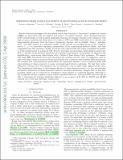EXPLORING SHORT GAMMA-RAY BURSTS AS GRAVITATIONAL-WAVE STANDARD SIRENS
Author(s)
Hughes, Scott A.; Nissanke, Samaya M.; Holz, Daniel E.; Dalal, Neal; Sievers, Jonathan L.
DownloadHughes_ExploringShort.pdf (1.536Mb)
OPEN_ACCESS_POLICY
Open Access Policy
Creative Commons Attribution-Noncommercial-Share Alike
Terms of use
Metadata
Show full item recordAbstract
Recent observations support the hypothesis that a large fraction of "short-hard" gamma-ray bursts (SHBs) are associated with the inspiral and merger of compact binaries. Since gravitational-wave (GW) measurements of well-localized inspiraling binaries can measure absolute source distances, simultaneous observation of a binary's GWs and SHB would allow us to directly and independently determine both the binary's luminosity distance and its redshift. Such a "standard siren" (the GW analog of a standard candle) would provide an excellent probe of the nearby (z [superscript < subscript ~] 0.3) universe's expansion, independent of the cosmological distance ladder, thereby complementing other standard candles. Previous work explored this idea using a simplified formalism to study measurement by advanced GW detector networks, incorporating a high signal-to-noise ratio limit to describe the probability distribution for measured parameters. In this paper, we eliminate this simplification, constructing distributions with a Markov Chain Monte Carlo technique. We assume that each SHB observation gives source sky position and time of coalescence, and we take non-spinning binary neutron star and black hole-neutron star coalescences as plausible SHB progenitors. We examine how well parameters (particularly distance) can be measured from GW observations of SHBs by a range of ground-based detector networks. We find that earlier estimates overstate how well distances can be measured, even at fairly large signal-to-noise ratio. The fundamental limitation to determining distance proves to be a degeneracy between distance and source inclination. Overcoming this limitation requires that we either break this degeneracy, or measure enough sources to broadly sample the inclination distribution.
Date issued
2010-11Department
Massachusetts Institute of Technology. Department of Physics; MIT Kavli Institute for Astrophysics and Space ResearchJournal
Astrophysical journal
Publisher
Institute of Physics ; American Astronomical Society.
Citation
Nissanke, Samaya et al. “EXPLORING SHORT GAMMA-RAY BURSTS AS GRAVITATIONAL-WAVE STANDARD SIRENS.” The Astrophysical Journal 725.1 (2010): 496-514. © IOP Publishing 2011
Version: Author's final manuscript
ISSN
0004-637X